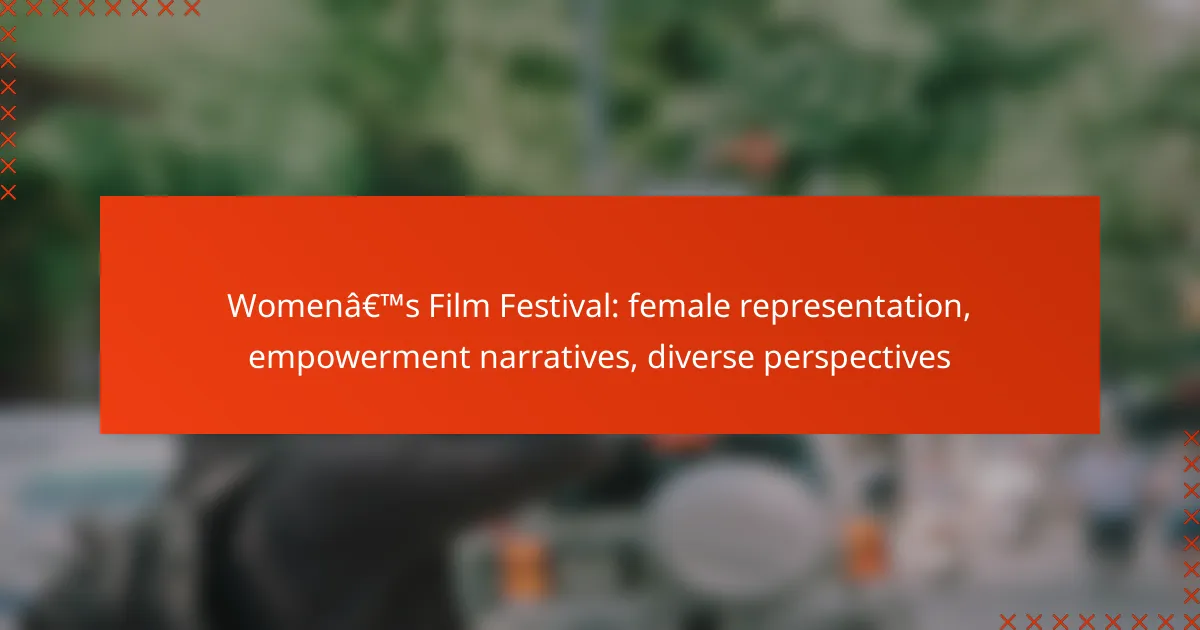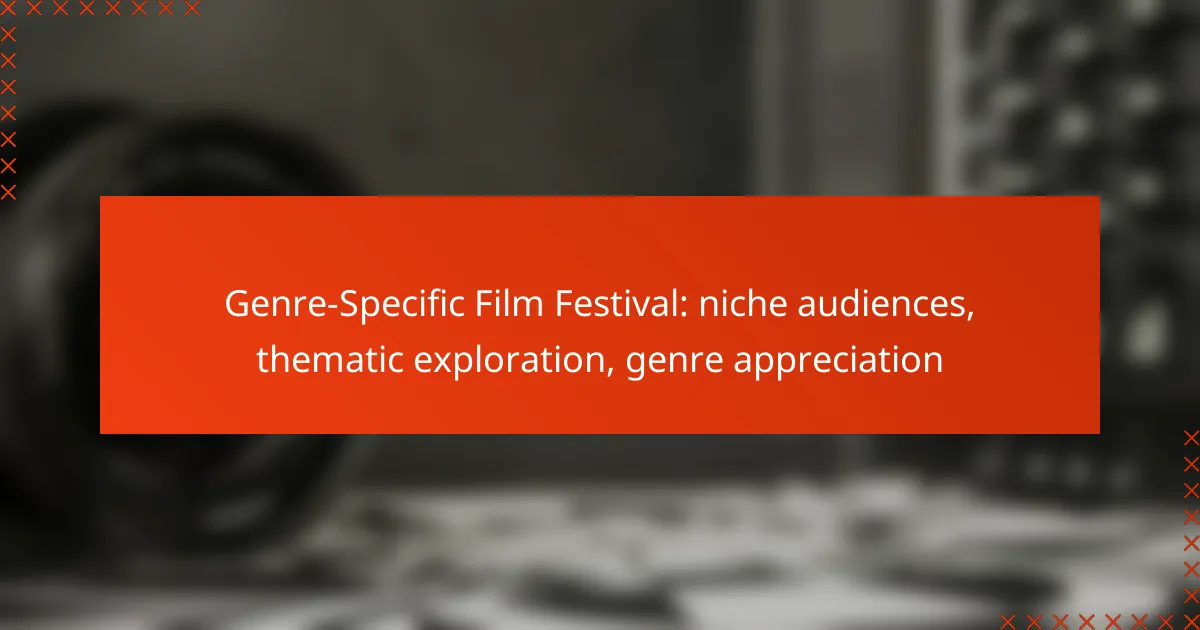The Women’s Film Festival serves as a vital platform for enhancing female representation in the film industry, showcasing the diverse narratives crafted by women filmmakers. By highlighting empowerment stories that celebrate women’s strength and resilience, these festivals inspire audiences and challenge societal norms, fostering a more inclusive cinematic landscape.
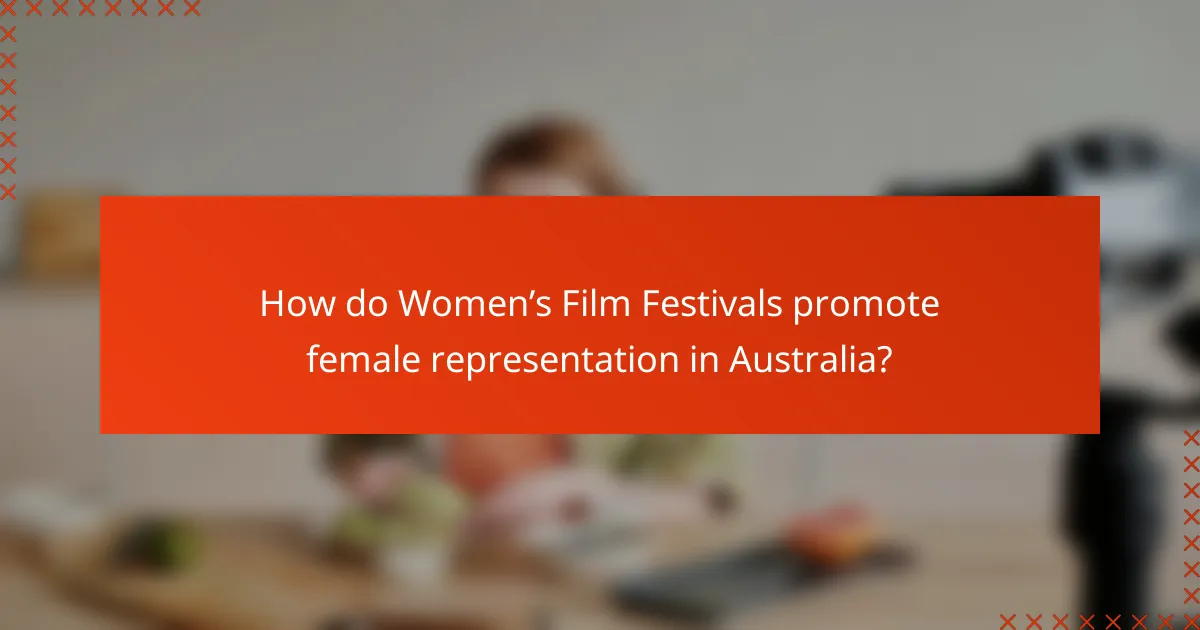
How do Women’s Film Festivals promote female representation in Australia?
Women’s Film Festivals in Australia play a crucial role in enhancing female representation by providing a platform for women filmmakers and their stories. These festivals showcase diverse perspectives, empowering women and fostering a more inclusive film industry.
Showcasing female filmmakers
Women’s Film Festivals actively highlight the work of female filmmakers, offering them visibility in an industry where they are often underrepresented. By featuring films created by women, these festivals encourage audiences to engage with their unique visions and experiences.
Many festivals include panels and discussions with female directors, producers, and writers, allowing them to share insights and challenges they face in the film industry. This not only promotes their work but also inspires aspiring filmmakers to pursue their passions.
Highlighting women’s stories
These festivals focus on narratives that center around women’s experiences, bringing attention to issues such as gender equality, empowerment, and social justice. By showcasing films that tell women’s stories, they contribute to a broader understanding of women’s roles in society.
Films presented at these festivals often explore themes of resilience, identity, and community, resonating with diverse audiences. This emphasis on women’s stories fosters empathy and encourages dialogue about important social issues.
Encouraging diverse narratives
Women’s Film Festivals promote a range of narratives that reflect the diversity of women’s experiences across different cultures and backgrounds. This encourages filmmakers to tell stories that may not fit mainstream narratives, enriching the film landscape.
By supporting films from various cultural perspectives, these festivals help to dismantle stereotypes and challenge societal norms. They create a space for underrepresented voices, ensuring that a variety of experiences are acknowledged and celebrated in the cinematic world.
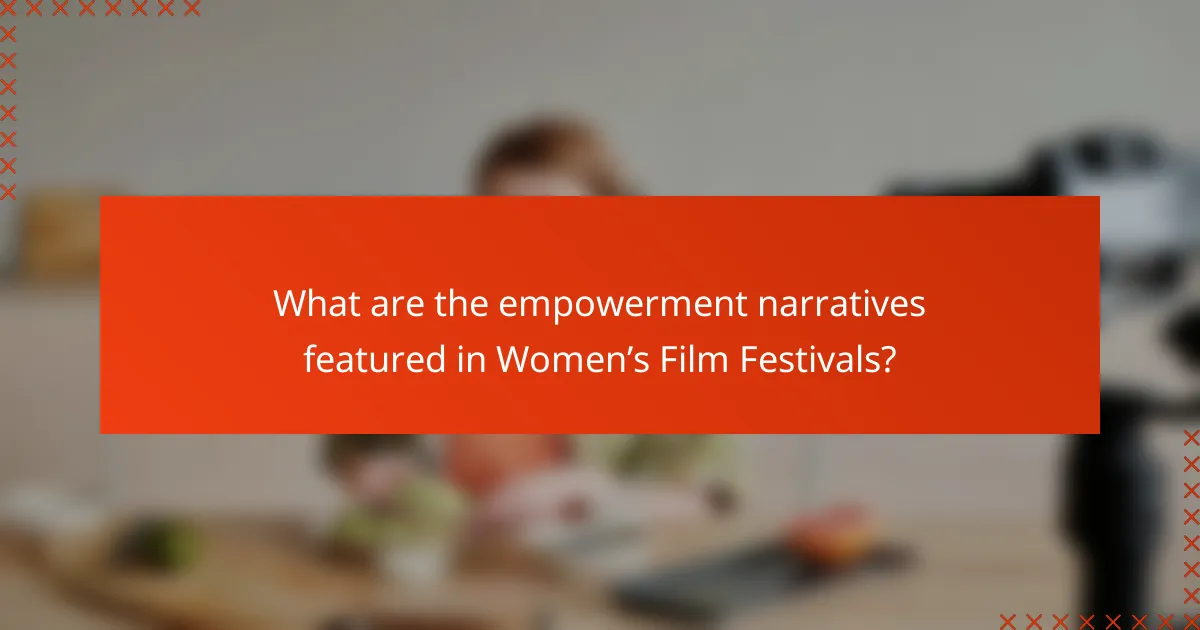
What are the empowerment narratives featured in Women’s Film Festivals?
Women’s Film Festivals highlight empowerment narratives that focus on women’s strength, resilience, and achievements. These narratives often showcase diverse perspectives that inspire and challenge societal norms, fostering a deeper understanding of women’s roles in various contexts.
Stories of resilience
Stories of resilience in Women’s Film Festivals often depict women overcoming significant challenges, such as personal trauma, societal barriers, or systemic oppression. These narratives resonate with audiences by illustrating the strength and determination required to navigate adversity.
For example, films may feature protagonists who rise from difficult circumstances, such as escaping abusive relationships or fighting for their rights in oppressive environments. These stories not only empower the characters but also inspire viewers to reflect on their own resilience.
Celebrating achievements
Celebrating achievements is a key theme in Women’s Film Festivals, where films highlight women’s contributions across various fields, including science, arts, politics, and sports. These narratives serve to recognize and honor the accomplishments of women who have made significant impacts in their communities and beyond.
Films may showcase real-life figures or fictional characters who break barriers and achieve success, providing role models for future generations. By spotlighting these achievements, festivals encourage a culture of recognition and support for women’s endeavors.
Challenging stereotypes
Challenging stereotypes is central to the empowerment narratives presented in Women’s Film Festivals. These films often confront and deconstruct traditional gender roles, presenting women in diverse and complex ways that defy societal expectations.
For instance, narratives may portray women in leadership positions, as skilled professionals, or as multifaceted individuals with their own stories. By showcasing these varied representations, festivals promote a broader understanding of women’s identities and capabilities, fostering a more inclusive dialogue about gender equality.

How do Women’s Film Festivals support emerging female talent?
Women’s Film Festivals play a crucial role in supporting emerging female talent by providing platforms that showcase their work and foster professional growth. These festivals create environments where women filmmakers can gain visibility, access resources, and connect with industry professionals.
Mentorship programs
Mentorship programs at Women’s Film Festivals connect emerging female filmmakers with experienced industry professionals. These relationships often provide invaluable guidance on storytelling, production techniques, and navigating the film industry.
Participants typically benefit from one-on-one sessions, workshops, and feedback on their projects. This direct support can significantly enhance their skills and confidence, helping them to refine their craft and expand their networks.
Networking opportunities
Networking opportunities at Women’s Film Festivals allow emerging female talent to meet peers and industry leaders. These interactions can lead to collaborations, partnerships, and even job offers, which are essential for career advancement.
Festivals often host panels, Q&A sessions, and informal gatherings designed to facilitate connections. Engaging with other filmmakers, producers, and distributors can open doors to new projects and funding sources.
Funding for projects
Many Women’s Film Festivals offer funding opportunities specifically aimed at female filmmakers. Grants, awards, and pitch competitions can provide the financial backing necessary to bring projects to life.
These funding initiatives often focus on diverse narratives and innovative storytelling, encouraging filmmakers to explore unique perspectives. Applying for these funds typically involves submitting a project proposal, budget, and sometimes a short film or treatment, making it essential for applicants to clearly articulate their vision and impact.

What criteria should filmmakers consider for festival submissions?
Filmmakers should focus on themes that highlight female representation and empowerment, adhere to specific festival guidelines, and ensure high production quality. These criteria can significantly enhance the chances of selection and resonate with festival audiences.
Focus on female-centric themes
Female-centric themes are crucial for festivals dedicated to women’s narratives. Filmmakers should explore stories that showcase women’s experiences, challenges, and triumphs, reflecting diverse perspectives. Themes could range from personal journeys to societal issues impacting women.
Consider incorporating elements that promote empowerment, such as resilience, leadership, and community support. This approach not only aligns with festival goals but also engages audiences looking for authentic representations of women’s lives.
Adherence to festival guidelines
Each film festival has specific submission guidelines that filmmakers must follow. These may include runtime limits, format requirements, and deadlines. Familiarizing yourself with these criteria is essential to avoid disqualification.
Pay attention to any thematic focuses or special categories that the festival may emphasize, such as intersectionality or cultural representation. Tailoring your submission to align with these guidelines can enhance its relevance and appeal.
Quality of production
High production quality is vital for standing out in a competitive festival landscape. Filmmakers should invest in good cinematography, sound design, and editing to create a polished final product. This attention to detail reflects professionalism and respect for the audience.
Consider seeking feedback from peers or industry professionals before submission. A fresh perspective can help identify areas for improvement and ensure that the film meets industry standards, increasing its chances of success at festivals.

How do Women’s Film Festivals impact audience perceptions?
Women’s Film Festivals significantly influence audience perceptions by showcasing diverse narratives that highlight female empowerment and representation. These festivals challenge traditional storytelling and promote a broader understanding of women’s experiences in society.
Shifting cultural narratives
Women’s Film Festivals play a crucial role in shifting cultural narratives by presenting stories that often go untold in mainstream cinema. By focusing on female protagonists and their journeys, these festivals encourage audiences to reconsider stereotypes and embrace more nuanced portrayals of women.
For example, films that explore themes of resilience, leadership, and creativity can reshape how society views women’s roles. This shift can lead to greater acceptance of diverse experiences and identities, ultimately fostering a more inclusive cultural landscape.
Encouraging discussions on gender
These festivals create a platform for critical discussions on gender issues, allowing audiences to engage with topics such as inequality, representation, and empowerment. Panel discussions, Q&A sessions, and workshops often accompany screenings, providing opportunities for deeper exploration of the themes presented in the films.
By facilitating dialogue, Women’s Film Festivals help to raise awareness and challenge existing norms, encouraging attendees to reflect on their own perceptions and biases regarding gender roles in society.
Fostering community engagement
Women’s Film Festivals foster community engagement by bringing together filmmakers, audiences, and advocates who share a commitment to promoting gender equity. These events often attract a diverse audience, creating a sense of solidarity and shared purpose among attendees.
Local initiatives, such as mentorship programs for aspiring female filmmakers or community screenings, can extend the festival’s impact beyond the event itself. By nurturing connections and collaborations, these festivals contribute to a supportive ecosystem that empowers women in the film industry.
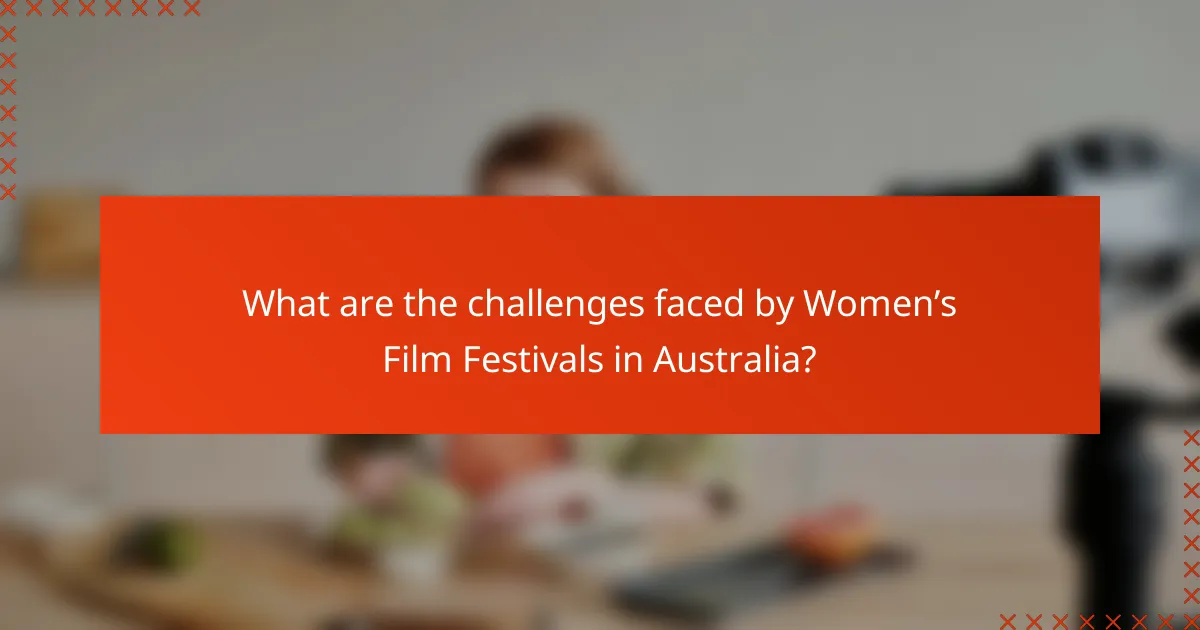
What are the challenges faced by Women’s Film Festivals in Australia?
Women’s Film Festivals in Australia encounter several challenges, primarily related to funding, audience engagement, and industry support. These obstacles can hinder their ability to showcase female representation and empowerment narratives effectively.
Funding limitations
Funding limitations pose a significant challenge for Women’s Film Festivals in Australia. Many festivals rely on government grants, sponsorships, and ticket sales, which can fluctuate and may not cover all operational costs. This uncertainty can restrict programming options and the ability to attract high-quality films.
To navigate funding limitations, festivals often seek partnerships with local businesses and organizations that align with their mission. Crowdfunding campaigns can also be an effective way to engage the community and raise necessary funds. However, these methods require strategic planning and marketing efforts to succeed.
Festivals should consider diversifying their funding sources by applying for international grants or collaborating with other festivals. This approach can enhance financial stability and provide access to a broader network of resources and audiences.
